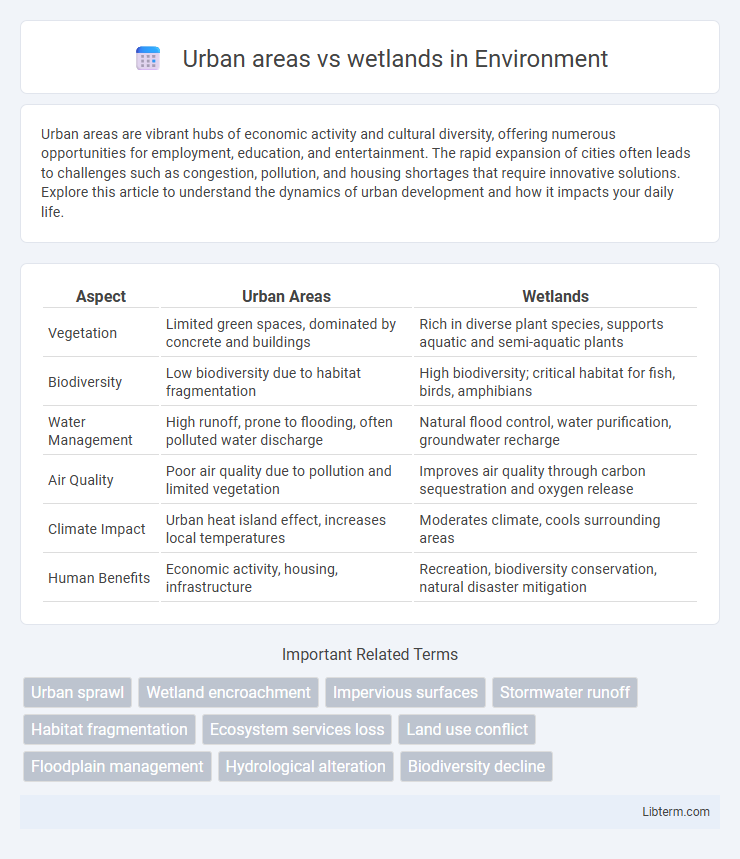Urban areas are vibrant hubs of economic activity and cultural diversity, offering numerous opportunities for employment, education, and entertainment. The rapid expansion of cities often leads to challenges such as congestion, pollution, and housing shortages that require innovative solutions. Explore this article to understand the dynamics of urban development and how it impacts your daily life.
Table of Comparison
| Aspect | Urban Areas | Wetlands |
|---|---|---|
| Vegetation | Limited green spaces, dominated by concrete and buildings | Rich in diverse plant species, supports aquatic and semi-aquatic plants |
| Biodiversity | Low biodiversity due to habitat fragmentation | High biodiversity; critical habitat for fish, birds, amphibians |
| Water Management | High runoff, prone to flooding, often polluted water discharge | Natural flood control, water purification, groundwater recharge |
| Air Quality | Poor air quality due to pollution and limited vegetation | Improves air quality through carbon sequestration and oxygen release |
| Climate Impact | Urban heat island effect, increases local temperatures | Moderates climate, cools surrounding areas |
| Human Benefits | Economic activity, housing, infrastructure | Recreation, biodiversity conservation, natural disaster mitigation |
Overview of Urban Areas and Wetlands
Urban areas consist of densely populated regions characterized by extensive infrastructure, residential buildings, commercial spaces, and transportation networks designed to support high human activity. Wetlands are ecosystems saturated with water, either permanently or seasonally, supporting diverse flora and fauna while providing critical ecological functions such as water filtration, flood control, and carbon storage. The contrast between urban areas and wetlands highlights the tension between development-driven land use and conservation of natural habitats that maintain biodiversity and environmental stability.
Key Characteristics of Urban Environments
Urban environments feature high population density, extensive built infrastructure, and significant human activity impacting natural ecosystems. Impervious surfaces such as concrete and asphalt dominate, leading to altered water cycles and increased surface runoff compared to wetlands. Urban areas also experience elevated temperatures due to the heat island effect, reduced biodiversity, and fragmented habitats.
Defining Features of Wetlands
Wetlands are characterized by water-saturated soils, unique hydric conditions, and a diverse assemblage of hydrophytic vegetation adapted to low oxygen levels. Unlike urban areas dominated by impervious surfaces and infrastructure, wetlands serve critical ecological functions such as water filtration, flood control, and habitat provision for a variety of species. These ecosystems maintain hydrological connectivity and support biodiversity, distinguishing them from the heavily modified landscapes typical of urban settings.
Ecological Functions of Wetlands
Wetlands play a critical role in urban environments by providing essential ecological functions such as water filtration, flood control, and habitat for biodiversity. Unlike urban areas dominated by impervious surfaces that increase runoff and pollution, wetlands act as natural sponges, absorbing excess stormwater and filtering pollutants before they reach rivers and lakes. Maintaining wetland ecosystems within or near cities supports urban resilience by improving water quality, mitigating flood risks, and sustaining diverse plant and animal species.
Urbanization and Its Impact on Biodiversity
Urbanization drastically alters natural habitats, leading to significant loss of wetland ecosystems that serve as critical biodiversity hotspots. The conversion of wetlands into urban areas disrupts water filtration, flood control, and species habitats, causing declines in native flora and fauna populations. Protecting remaining wetlands amidst expanding urban development is essential to preserving ecosystem services and maintaining regional biodiversity.
Flood Management: Urban Areas vs Wetlands
Urban areas rely heavily on engineered flood management systems such as levees, storm drains, and retention basins to control water flow and prevent flooding. Wetlands naturally absorb excess rainfall, slowing runoff and reducing flood peaks through their spongy soil and dense vegetation. The preservation of wetlands significantly enhances flood resilience by providing natural buffer zones that mitigate the impact of heavy storms and reduce urban flood risk.
Water Quality: Wetland Filtration vs Urban Runoff
Wetlands naturally filter pollutants such as nitrogen, phosphorus, and heavy metals from water, significantly improving water quality by trapping sediments and breaking down contaminants. In contrast, urban runoff carries high loads of pollutants including oil, chemicals, and trash directly into waterways, leading to increased water pollution and degraded aquatic ecosystems. The absence of filtration mechanisms in urban areas causes elevated levels of contaminants, contributing to eutrophication and harmful algal blooms.
Climate Regulation in Cities and Wetland Ecosystems
Urban areas significantly alter local climate through heat island effects, increasing temperatures and reducing natural cooling. Wetland ecosystems contribute to climate regulation by sequestering carbon dioxide, moderating temperatures, and managing floodwaters. Integrating wetlands into urban planning enhances climate resilience and mitigates urban heat impacts.
Land Use Conflicts and Conservation Strategies
Urban areas often encroach on wetlands, leading to significant land use conflicts due to competing demands for development and ecosystem preservation. Wetlands provide critical ecosystem services, including flood control, water purification, and habitat for biodiversity, making their conservation essential amid urban expansion. Strategies such as establishing protected wetland zones, implementing sustainable urban planning, and promoting green infrastructure help mitigate conflicts and support wetland conservation in urbanizing regions.
Policy Approaches for Balancing Development and Wetland Protection
Policy approaches for balancing urban development and wetland protection include implementing strict zoning regulations to limit construction near sensitive wetland areas and enforcing buffer zones that preserve natural habitats. Incentive programs promote sustainable building practices and wetland restoration projects that mitigate environmental impacts while supporting urban growth. Integrating wetland ecosystem services valuation into urban planning ensures long-term economic and ecological benefits, fostering collaboration between developers, policymakers, and conservationists.
Urban areas Infographic

 libterm.com
libterm.com